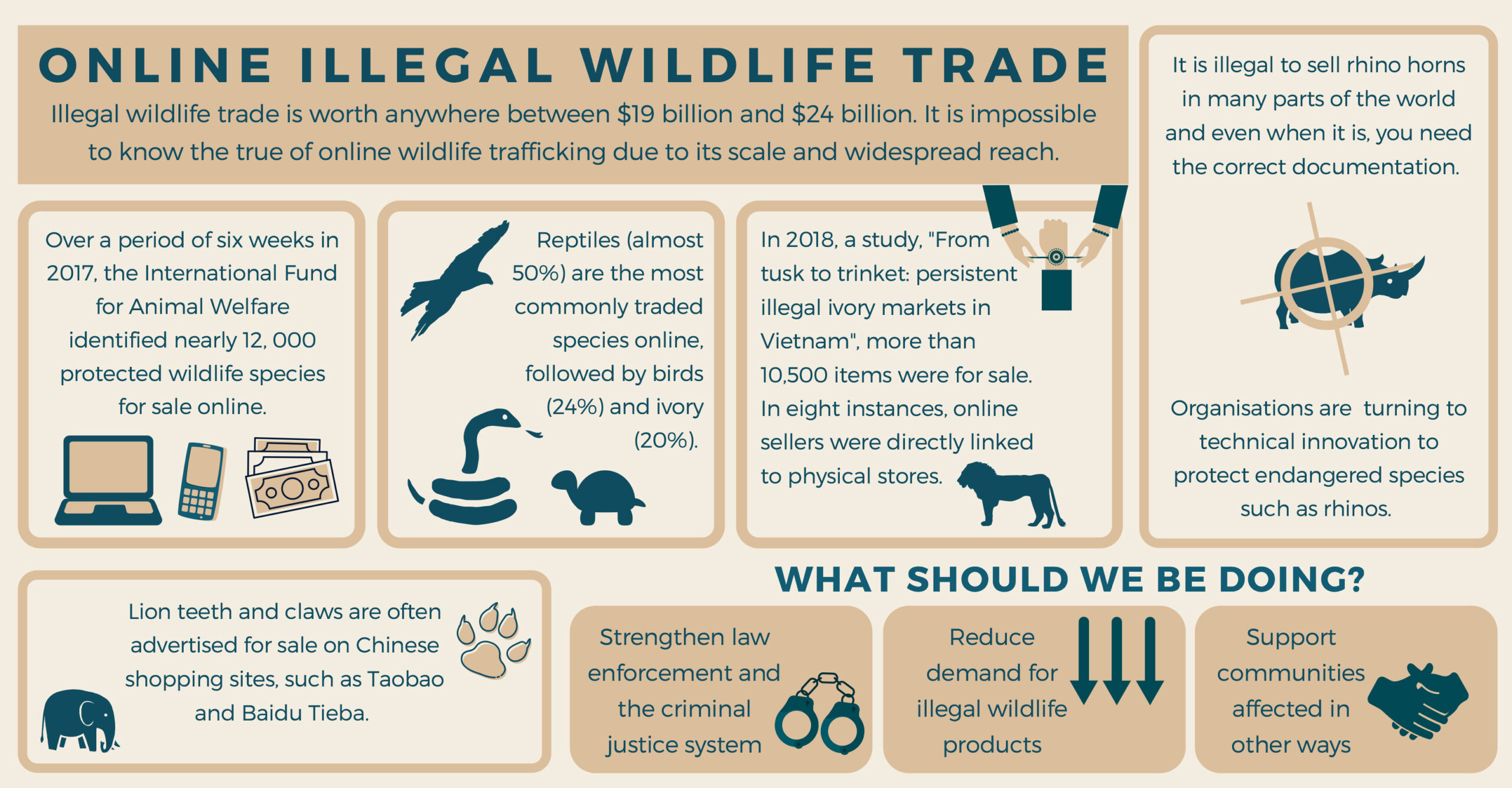Illegal wildlife trade is a multi-billion-dollar industry that involves endangered and protected species, their parts, and products. Leaving behind a trail of destruction, wiping out biodiversity and livelihoods, it accounts for around $23 billion annually.
According to a report by the World Wildlife Fund, the illegal wildlife trade is the fourth-largest illicit trade in the world, after drugs, arms, and human trafficking.
The industry clearly sustains on the rising demand for animal products, ranging from luxury goods to seafood to traditional medicine. On the other hand, due to structural violence like extreme poverty, people see wildlife as a potential source of barter for trade.
We live in a world where the media is an integral part of everything we do. Media isn’t static, but evolutionary, and so are its uses.
In the last few decades, social media like Facebook and Instagram have provided platforms for a plethora of online businesses, whether legal or illicit. This is due to its prominent role in the illegal wildlife trade.
Making it easier for traffickers to reach a wider audience and sell illegal products. The anonymity and accessibility provided by social media platforms make it easier for them to connect with potential buyers, without fear of being caught by law enforcement agencies.
In addition, it allows you to build trust between buyers and sellers which is essential when dealing in large quantities and has safer payment mechanisms. In particular, during the COVID-19 pandemic when the entire world was quarantined, virtually everything could be accessed with a click of a button.
The Illegal Wildlife Trade Web:
‘Wildlife’, not only means mammals, as commonly perceived, rather it refers to other taxonomic groups including plants, birds, fishes etc.
Trafficking and the unsustainable trade of wildlife for goods like elephant ivory, rhino horn, pangolin scales etc., across the globe, can cause a ravaging decline in wildlife species. High-profit margins are usually driven by demand, which is based on certain myths.
For instance, in Vietnam, the myth that rhino horn cures cancer led to massive poaching activities in South Africa.
Coupled with gaps in protection systems like corruption, weak judicial systems and weak sentences, allows highly-organized syndicates to plunder wildlife till nature cannot replenish its stocks to keep up with human demand. Often the poorest in the third world are the most adversely affected by rising illicit trade. Many communities.
Use of social media in the Illicit Wildlife Trade
In a world where everything is just a click away, social media and its algorithms assist poachers and highly organized syndicates in connecting among themselves.
Furthermore, with a single post of an animal like a big cat or pangolin or of an animal product, a seller can reach out to buyers, starting DMs to sending them an invite to a private chat, in most cases the process ends with daylight robbery.
Like any other grocery item even endangered species can be shipped offline.
Although the dated laws provide a leavy to tech corporate protection to reconstruct or develop any mechanism to reduce such illicit activities on their platforms.
Moreover, the girth of content posted daily on social media platforms limits the success of the corporation in detecting and removing illegal wildlife trade content from their platforms.
In addition, there is no end to the use of code phrases referring to a particular product, for example, elephant tusk is indicated as ‘white’.
Furthermore, most detecting mechanisms have a platform-based approach, which is vital for collecting data but not time efficient and limited to only a few platforms.
What is being done to limit social media use in illicit wildlife trade?
The Convention on International Trade in Endangered Species of Wild Fauna and Flora (CITES) defines Wildlife crime linked to the internet as ‘Crime involving any wildlife specimen, enabled or facilitated by the use of information and communication technology networks or any application in the digital world, including inter alia the public (clear) web, the dark web, online marketplaces, social network platforms, instant chat applications, peer to peer networks or email services.’
Even though there are 183 parties to the Convention, its implementation varies from country to country. Yet it grapples with issues to address wildlife cybercrime.
Therefore, the revised resolution noted that recommendations suggest that Parties ‘identify key contacts at online technology and data companies that can facilitate the provision of information upon request from Parties in support of investigations.’
Nevertheless, even the most profound companies find it difficult to fully investigate due to the mammoth number of ads and organizations.
Many such organizations or advertisements escape from the legal repercussion because of the use of hazy images or labelling the product as ‘antique’ or ‘pre-ban’.
To combat this, social media companies must take a more proactive role in detecting and removing illegal wildlife trade content from their platforms.
Along with the concretized legislation which seeks to provide responsibility to online service providers with a comprehensive address of crucial questions on how to manage and balance free speech, legitimate commerce, illegal trade and privacy and security of users against dangerous communication.
As merely deleting or reporting the problematic accounts will not be a sustainable solution.
Law enforcement agencies can incorporate a comprehensive understanding of the behaviors and attitudes of buyers and sellers on social media platforms. To work together to crack down on the illegal wildlife trade and hold traffickers accountable for their crimes.


